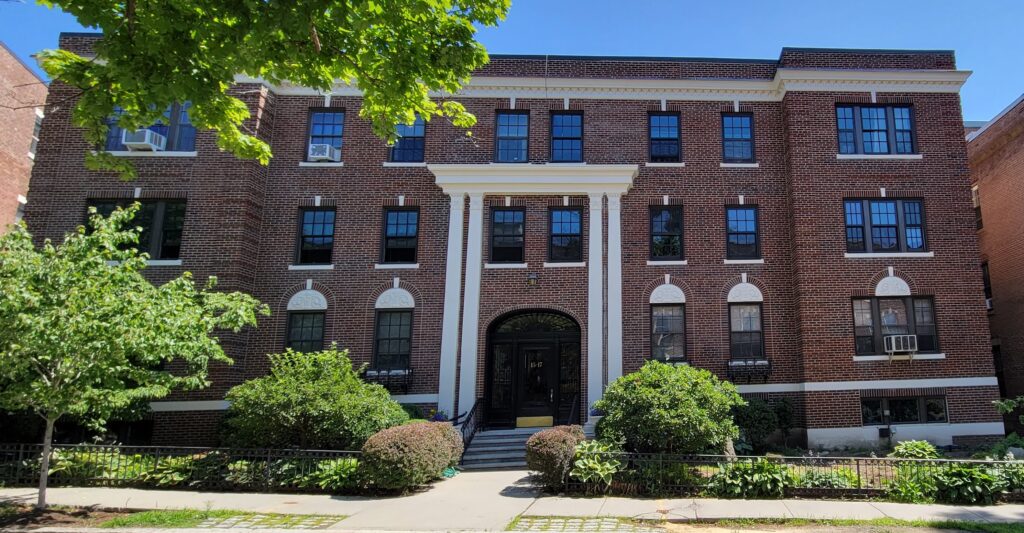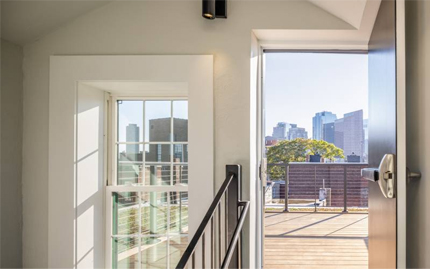This article was published in the August 2023 issue of Condo Media.

Collaboration led to a precast portico being replaced with a fiberglass cornice at 15-17 James St., Brookline.
By Kieran Fitzgibbon
“Together” is a word that is used more often than it is meant.
Politicians talk about “working together,” but rarely do. Professional athletes and coaches talk about playing as a team, but superstars often follow the money, not their teammates. And in business, “working together” often means letting someone else do the work, then taking credit for it.
But when people really and truly work together, everyone benefits. During nearly 30 years of restoration work, we’ve found that when everyone collaborates effectively, work can be completed more quickly, and at a higher quality and lower cost.
So how do we, and those we work with, combine our talents and expertise for the greater good? For us, “collaboration” is spelled with five C’s – communication, cost, creativity, cooperation and caring. These factors are at the core of working together.
Communication. Communication is challenging, because many parties are involved in a typical project and each party has its own needs. There’s the property manager and the Board of Trustees, which represents all owners. There are architects and engineers, a general contractor, and many subcontractors. Specialists may be hired for staging, painting, roofing, windows and more. Permits must be obtained from local building officials – which may include a zoning board, a planning board, a building inspector, a historic preservation commission and others.
When a condominium she’s managing needs to be restored or upgraded, the first crucial step for Ann D. Stefanelli, President of The Stefanelli Company, Inc. in West Roxbury, Mass., is to gain the support of the Board of Trustees.
“It’s often a challenge,” she said. “It takes multiple meetings to get the board to understand the complexity of a construction effort. A board is typically cost-driven, and trustees often feel responsible when building deficiencies arise. Boards do not create the building’s problems, yet they’re charged with the cumbersome duty to fix and repair them. To fund construction projects, Board members are also responsible for levying assessments, which may upset owners.”
Stefanelli brings in professionals to meetings to explain what should be done and why. This collaborative effort often assists boards in further understanding the necessity of projects.
“Project managers and contractors must comply with building codes of various municipalities, and be mindful of issues such as water infiltration,” she said. “We need to consider liabilities and possibly mold contamination.”
Once the board approves the project and a building envelope consultant is hired, communication continues to be vital, according to Edward Moll, P.E., principal of Structures North Consulting Engineers, Inc. in Salem, Mass.
“Board members often have a lot of misinformation,” he said. “They’re usually not technical and they do not understand what’s going on. They have information from old projects that they try to apply to a new project.”
Moll depends on the property manager to work with the board. “They absolutely have to be an advocate for us,” he said. “It’s a difficult job.” Working together, he said, is “a matter of staying focused. It’s a matter of educating them and keeping them informed.”
From the beginning, their objectives are usually at odds. The property manager, board and owner understandably want to keep costs low. They may be satisfied with a temporary fix. The consultant wants to make certain the job is done right.
“Communication is 100% of the game to me,” said Matthew Copeland, principal of Copeland Building Envelope Consulting, Inc. (CopelandBEC) of Hudson, Mass. “Communication is the number one differentiator in a service business like ours. Being able to communicate our ideas, our solutions, our findings in a way that decision makers can understand is essential. It is the most valuable thing we can offer.”
Copeland added that clear communication of the current situation is needed, and it must be based on “facts and observable truths, as opposed to speculation.”
To do the job right, the consultant needs precise information to determine the cause or causes of a specific problem, develop a solution and budget accurately, but such information is often unavailable.
“There was a 30-unit condominium, and we were trying to figure out where the problems were by surveying unit owners,” Moll said. “The information we received was poor and inaccurate. Ten-year-old leaks were being reported as active leaks. Pictures couldn’t tell us where the leaks were and the board didn’t want to spend the money to do things properly.”
From the start of the project until its completion, the interests of unit owners must also be considered. Communication can be complicated, because some owners have different needs than others, Stefanelli said. Some unit owners may have water leaking into their unit, for example, while others do not and may not see the need for mitigation.

Owners need to be informed when staging is going up.
Unit owners also need to know when staging and construction equipment will be taking over their building, and when noisy renovations will be taking place.
“In a condominium, we are a community,” Stefanelli said. “We need to communicate with clarity to all unit owners.”
But meetings with owners can become contentious – especially when some perceive that they will be paying a higher assessment for a project that may not affect them.
“One of the things I require when I manage a condominium is respect for all,” Stefanelli said. “When dollars are high, emotions are high. People get angry. Board members and unit owners may disagree, but we always require that they disagree respectfully.”
How contractors communicate with consultants, engineers and architects will also affect the outcome of the project.
According to Steven A. Dannin, PCAM, President of Dannin Management Corporation in Brookline, Mass., “When there’s one central point of communication, it simplifies the process. We meet at the property and go over it. Active involvement makes communication easy. You can’t manage properties from behind a desk. It has to be done in person.”
Cost. There is usually a discrepancy between what the client expects to spend and the likely cost, according to Copeland.
“There is almost always a gap – especially lately,” he said. “The costs of things have changed so drastically, so quickly, and so often.” Unfortunately, this makes budgeting difficult, especially when there is a long pre-construction period.
“The longer a project takes to begin, the greater the likelihood that prices will change significantly,” he said. “Someone may have gotten pricing information six months ago and today it’s totally out of date.”
Project costs also increase when the scope of the project changes. When water infiltration is an issue, it’s difficult to define the scope of the project until the consultant and general contractor look behind the walls.
“Surprises are unavoidable,” Copeland said, “but you can plan for surprises and try to mitigate the financial impact. You know from experience that something’s always going to be different than what you expected.” A contingency is typically used to account for cost increases so that “over the arc of the project, it is reasonable to stay within the overall financial plan even with major surprises in terms of scope.”
Sometimes boards want to save money by using inferior materials or otherwise compromising the integrity of the project. Copeland, Dannin and Moll all said they would walk away from a project before they would consider a cheap fix. Instead, they frequently break projects into phases, so boards can budget the costs over a longer period.

An engineer initially though the fifth floor of this building would have to be replaced, but a team working together salvaged it and the rooftop was made into an attractive area.
“We’re not going to do it the wrong way,” Dannin said. “If the budget isn’t big enough for the whole project, we’ll suggest tackling a small portion of a big problem correctly.”
Creativity. When the board lacks the budget to complete a project and dividing the project into two or more phases isn’t an option, creative solutions can sometimes be found.
Stefanelli cited a 23-unit condominium at 16 Addington Road in Brookline where Statewide RM was the general contractor. Based on design alternatives presented, the board recognized that the best approach was to replace the entire skin of the building. However, at a cost of $5 million, that option proved unaffordable.
Collaborating with the design team, Statewide RM came up with a plan to focus on the fifth floor, which was the primary source of the leaks. The project was completed for $1,497,000 and the condominium has been leak-free since the project was completed, Stefanelli said.
Creativity was also needed when replacing a portico at 15-17 James St., Brookline. An analysis from CopelandBEC found that the portico had deteriorated to the point where it could not be repaired, but building a new portico out of precast concrete was cost prohibitive.
CopelandBEC and Statewide collaborated on a plan, replacing the portico with a cornice made from fiberglass. The new cornice is “visually appealing, with less weight and a lower cost” than a new cast-stone portico would have been, Copeland said.
The top floor of 22 Fleet St., Boston, provides another example of creative collaboration. It was in such poor condition, an engineer initially thought it would have to be replaced. Statewide and a structural engineer worked together to ensure that the fifth floor could be salvaged safely and reconstructed, saving $1 million.
Cooperation. When professionals have a history of working together successfully, they are more likely to trust and respect each other.
“The consultant will want an architect and engineer on the job that he or she has worked with long enough to trust,” Moll said. “His reputation depends on the work that they do. If they’re not all working together, the consultant is in trouble.”
Even when the design team members are aligned, they are often at odds with contractors. Sometimes, the challenge “isn’t being a team, it’s working as a team,” Copeland said. “We try to look at any given project group as a team, imagine that we are all pointing toward the same end and come to an agreement.”
Moll added that to achieve cooperation, “The contractor has to have respect for the consultant, and the consultant has to have respect for the contractor.”
Caring. When a restoration project takes place, people’s homes and finances are affected, so “a level of care has to be exercised,” Stefanelli said.
But doing so sometimes requires a difficult balance. In the Addington Road project, many residents had been owners since the project was constructed, so they had a lot of equity in their homes and could fund the effort. Others had just moved in at the top of the market, and they needed some flexibility to pay for the project.
Caring must be reflected by all parties, throughout the project, according to Dannin, who said, “A caring approach requires a level of consistency. You have to go step by step.”
Everyone’s needs must be considered throughout the process, he said, and often costs must be spread out to make a project work. The project team must consist of professionals who can proceed step by step with empathy and understanding.
“You can’t teach someone to care,” Dannin said.
Kieran Fitzgibbon is co-owner of Statewide RM of Brighton, Mass., which specializes in masonry restoration for condominiums. He can be reached at [email protected].

